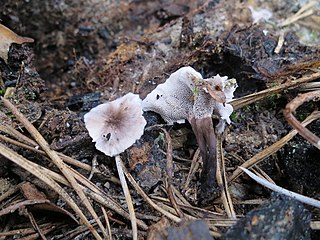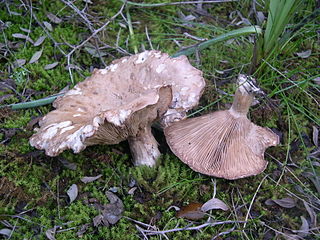
A clamp connection is a hook-like structure formed by growing hyphal cells of certain fungi. It is a characteristic feature of basidiomycete fungi. It is created to ensure that each cell, or segment of hypha separated by septa, receives a set of differing nuclei, which are obtained through mating of hyphae of differing sexual types. It is used to maintain genetic variation within the hypha much like the mechanisms found in croziers (hooks) during the sexual reproduction of ascomycetes.

Hydnellum peckii is a fungus in the genus Hydnellum of the family Bankeraceae. It is a hydnoid species, producing spores on the surface of vertical spines or tooth-like projections that hang from the undersurface of the fruit bodies. It is found in North America, Europe, and was recently discovered in Iran (2008) and Korea (2010). Hydnellum peckii is a mycorrhizal species, and forms mutually beneficial relationships with a variety of coniferous trees, growing on the ground singly, scattered, or in fused masses.

Hydnellum is a genus of tooth fungi in the family Bankeraceae. Widely distributed in the Northern Hemisphere, the genus contains around 40 species. The fruitbodies of its members grow by slowly enveloping nearby bits of grass and vegetation. There is great variability in the form of Hydnellum fruitbodies, which are greatly influenced by environmental conditions such as rainfall and humidity, drying winds, and temperature. They are too tough and woody to eat comfortably. Several species have become the focus of increasing conservation concern following widespread declines in abundance.

Phellodon is a genus of tooth fungi in the family Bankeraceae. Species have small- to medium-sized fruitbodies with white spines on the underside from which spores are released. All Phellodon have a short stalk or stipe, and so the genus falls into the group known as stipitate hydnoid fungi. The tough and leathery flesh usually has a pleasant, fragrant odor, and develops a cork-like texture when dry. Neighboring fruitbodies can fuse, sometimes producing large mats of joined caps. Phellodon species produce a white spore print, while the individual spores are roughly spherical to ellipsoid in shape, with spiny surfaces.

Hydnellum ferrugineum, commonly known as the mealy tooth or the reddish-brown corky spine fungus, is a species of tooth fungus in the family Bankeraceae. A widely distributed species, it is found in north Africa, Asia, Europe, and North America. The fungus fruits on the ground singly or in clusters in conifer forest, usually in poor or sandy soil. Fruit bodies are somewhat top-shaped, measuring 3–10 cm (1–4 in) in diameter. Their velvety surfaces, initially white to pink, sometimes exude drops of red liquid. The lower surface of the fruit body features white to reddish-brown spines up to 6 mm long. Mature fruit bodies become dark reddish brown in color, and are then difficult to distinguish from other similar Hydnellum species. H. ferrugineum forms a mat of mycelia in the humus and upper soil where it grows. The presence of the fungus changes the characteristics of the soil, making it more podzolized.

Phellodon sinclairii is a native tooth fungus found in beech forests of New Zealand. It was first described by Miles Joseph Berkeley in 1867 as a species of Hydnum in Joseph Dalton Hooker's work Handbook of the New Zealand Flora. The type locality was on Maungatua. Gordon Herriot Cunningham transferred the species to the genus Phellodon in 1958.

Hydnellum scrobiculatum, commonly known as the ridged tooth, is a tooth fungus in the family Bankeraceae. Widely distributed in the Northern Hemisphere, it is found in Asia, Europe, and North America.

Phellodon secretus is a rare species of tooth fungus in the family Bankeraceae. Described as new to science in 2003, it is found in Finland, where it grows under the fallen trunks of pine trees. It somewhat resembles Phellodon connatus, but has a thinner stipe, a softer, cotton-like cap, and smaller, rounder spores.
Phellodon putidus is a species of tooth fungus in the family Bankeraceae. Found in North America, it was first described scientifically by George F. Atkinson as Hydnum putidum in 1900. Howard James Banker transferred it to the genus Phellodon in 1906.
Phellodon tenuis is a species of tooth fungus in the family Bankeraceae. Found in Brazil, it was described as new to science in 1988 by Richard Baird.
Phellodon mississippiensis is a species of tooth fungus in the family Bankeraceae. It was described as new to science by mycologist Richard Baird in 2014 from collections made in the Tombigbee National Forest in Mississippi. It is one of the few Phellodon species with clamp connections in the hyphae.
Phellodon excentrimexicanus is a species of tooth fungus in the family Bankeraceae. Found in Mexico, it was described as new to science in 1985 by mycologist Richard Baird. It is similar in appearance to Phellodon fibulatus, which is found in the southern Appalachian Mountains, but the Mexican species lacks clamp connections, and its stipe is consistently eccentric.

Phellodon atratus is a species of tooth fungus in the family Bankeraceae. Found in North America, it was described as new to science in 1964 by Canadian mycologist Kenneth A. Harrison. It occurs most frequently closer to the Pacific coast and under Sitka spruce.
Phellodon implicatus is a species of tooth fungus in the family Bankeraceae. It was described as new to science in 1986 from collections made in Florida. It is one of the few Phellodon species known to possess clamp connections in its hyphae.
Phellodon maliensis is a species of tooth fungus in the family Bankeraceae. Found in Australia, it was originally described as a new species by Curtis Gates Lloyd in 1923. It was originally placed in Hydnum, until Dutch mycologist Rudolph Arnold Maas Geesteranus transferred it to the genus Phellodon in 1966.

Phellodon niger, commonly known as the black tooth, is a species of tooth fungus in the family Bankeraceae, and the type species of the genus Phellodon. It was originally described by Elias Magnus Fries in 1815 as a species of Hydnum. Petter Karsten included it as one of the original three species when he circumscribed Phellodon in 1881. The fungus is found in Europe and North America, although molecular studies suggest that the North American populations represent a similar but genetically distinct species.

Phellodon melaleucus, commonly known as the grey tooth, is a species of tooth fungus in the family Bankeraceae. It was originally described by Elias Magnus Fries in 1815 as a species of Hydnum. In 1881, Petter Karsten included it as one of the original three species in his newly circumscribed genus Phellodon. The fungus is widely distributed in Europe and North America, where it associates mycorrhizally with a wide range of host trees. It is considered vulnerable in Switzerland.

Sarcodon rimosus, commonly known as the cracked hydnum, is a species of tooth fungus in the family Bankeraceae. Found in the Pacific Northwest region of North America, it was described as new to science in 1964 by mycologist Kenneth A. Harrison, who initially called it Hydnum rimosum. He transferred it to the genus Sarcodon in 1984. Fruit bodies of S. rimosum have convex to somewhat depressed caps that are 4–12 cm (1.6–4.7 in) in diameter. The surface becomes scaly in age, often developing conspicuous cracks and fissures. It is brown with violet tints. The flesh lacks any significant taste and odor. Underneath the cap cuticle, the flesh turns a bluish-green color when tested with a solution of potassium hydroxide. The brownish-pinks spines on the cap underside are typically 2.5–7 mm long, extending decurrently on the stipe. Spores are roughly spherical with fine warts on the surface, and measure 5–6.5 by 4.5–5 µm. The hyphae do not have clamp connections.
Kenneth A. Harrison was a Canadian mycologist. He was for many years a plant pathologist at what is now the Atlantic Food and Horticulture Research Centre in Nova Scotia. After retirement, he contributed to the taxonomy of the Agaricomycotina, particularly the tooth fungi of the families Hydnaceae and Bankeraceae, in which he described several new species.

Clitopaxillus alexandri is a species of fungus in the family Pseudoclitocybaceae. It has been given the recommended English name of Alexander's funnel. Basidiocarps are agaricoid and resemble those of Clitocybe species. The species is saprotrophic and is mainly known from Europe.










